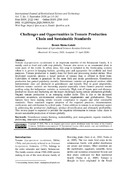| dc.description.abstract | Tomato(Lycopersicon esculentum) is an important member of the Solanaceae family. It is mainly used as food and cash crop globally. Tomato also serves as an ornamental plant in some parts of the world. In urban areas, thiscrop is included in the foodscaping systems where it is grown in hanging baskets, growing pots and aquaponics for aesthetic and food purposes. Tomato production is mainly done for fresh and processing market niches. Most developed countries process a larger portion of tomato than is offered in fresh form. Cultivation of tomato is practiced on the open field and inside greenhouses. Greenhouse production has gained popularity recently. Determinate varieties are produced outdoor while indeterminate ones are produced in greenhouses and tunnels. Due to good adaptability, heirloom tomato varieties are becoming popular especially where farmers practice tomato grafting using the indigenous varieties as rootstocks. High cost of inputs, pest and diseases, postharvest losses and marketing are the major challenges facingtomato production globally. Organic tomato production is an emerging market niche. This is due to the increased consumer awareness, environmental conservation requirements and globalization. Thus, farmers have been making strides towards compliance to organic and other sustainable standards. These standards require adoption of the requisite practices, documentation, verification and certification by a third party. Value addition in tomato is an important aspect in addressing the postharvest challenges, product diversification and ultimately profitability. Thisreview paper is expected to provide the requisite information in tomato value chain to ensure sustainable production of tomato globally. | en_US |
